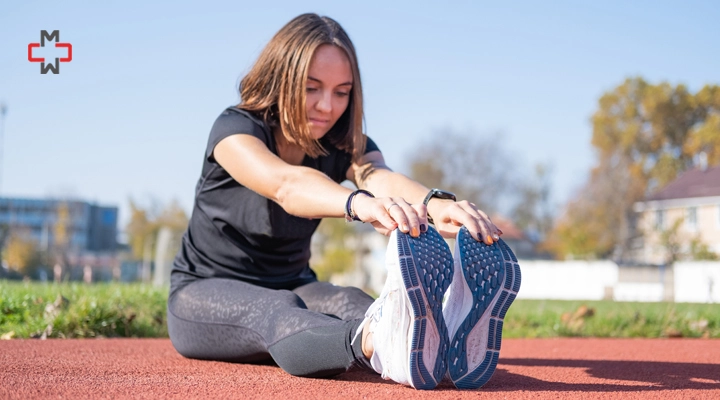Are you struggling with Achilles tendonitis and experiencing pain in your lower leg? Finding relief can be simpler than you think. This blog will explore strengthening exercises designed to alleviate discomfort and promote healing quickly. Whether you’re an athlete, a fitness enthusiast, or someone who spends long hours on their feet, these exercises target the Achilles tendon effectively.
From gentle stretches to strengthening routines, incorporating these exercises into your daily routine can help reduce pain, improve flexibility, and prevent future issues. Discover how a few minutes of Achilles tendonitis exercise a day can make a significant difference in managing it and getting back to your active lifestyle.
What Is Achilles Tendonitis?
Achilles tendonitis is a common condition characterized by the inflammation of the Achilles tendon, which connects the calf muscles to the heel bone. It often results from overuse, repetitive strain, or improper footwear, leading to pain and stiffness in the back of the lower leg.
Causes of Achilles Tendonitis
Several factors contribute to the development of Achilles tendonitis:
- Overuse: Engaging in activities that stress the Achilles tendon, such as running or jumping, without adequate rest.
- Tight Calf Muscles: Reduced flexibility in the calf muscles can increase strain on the Achilles tendon.
- Poor Footwear: Wearing shoes that do not provide proper support or sudden changes in footwear.
- Age and Physical Activity: Middle-aged individuals and athletes are more susceptible.
- Medical Conditions: Conditions like flat feet or arthritis can predispose individuals to Achilles tendonitis.
What Are The Symptoms Of Achilles Tendonitis?
Common symptoms of Achilles tendonitis include:
- Pain and stiffness along the tendon, especially in the morning or after physical activity.
- Swelling or tenderness in the Achilles tendon area.
- Thickening of the tendon.
- Limited range of motion and difficulty walking or participating in activities.
Achilles Tendonitis Exercises
Stretching Achilles exercises can help alleviate Achilles tendonitis symptoms and improve flexibility. Here are effective Achilles stretches:
– Eccentric Calf Raises
- Stand on a step or platform with your heels hanging off the edge.
- Rise up on both toes, then slowly lower your heels below the level of the step.
- Use your unaffected foot to return to the starting position.
- Repeat 10-15 times for three sets.
– Heel Drops
- Stand on a step or ledge with your heels off the edge.
- Lower your heels below the level of the step, feeling a stretch in the Achilles tendon.
- Hold for a few seconds, then slowly lift your heels. Repeat 10-15 times for three sets.
– Calf Muscles Stretch
- Seated and keep your knee straight.
- Stand facing a wall with one foot in front of the other.
- Lean forward, keeping your back heel on the ground, until you feel a stretch in your calf.
- Hold for 30 seconds, then switch legs. Repeat 2-3 times on each side.
– Seated Calf Stretch
- Sit on the floor with your leg straight in front of you.
- Loop a towel or resistance band around the ball of your foot and gently pull it towards you.
- Hold for 30 seconds, then switch legs. Repeat 2-3 times on each side.
– Resistance Band Exercises
- Sit on the floor with your legs extended.
- Loop a resistance band around the ball of your foot and gently pull it towards you.
- Hold for 30 seconds, then switch legs. Repeat 2-3 times on each side.
– Foam Rolling
- Sit on the floor with your legs extended and knees straight.
- Use a foam roller to gently massage the calf muscles and Achilles tendon area.
- Roll back and forth for 1-2 minutes, focusing on any tight or tender spots.
– Soleus Stretch
- Stand facing a wall with one foot in front of the other, the knees slightly bent.
- Gently bend both knees, keeping your heels on the ground.
- You should feel a stretch in the lower part of your calf (the soleus muscle).
- Maintain the stretch for 30 seconds, keeping your back straight and avoiding bouncing.
- Repeat the stretch on the other leg.
Tips To Prevent Achilles Tendinopathy
To reduce the risk of Achilles tendinopathy:
- Gradually increase exercise intensity and duration.
- Wear appropriate footwear with good arch support.
- Stretch and warm up before physical activity.
- Strengthen calf muscles through regular exercises.
When To See A Doctor?
You should see a doctor if you experience severe pain, swelling, or difficulty walking due to Achilles tendonitis. Persistent symptoms despite home treatments also warrant medical attention to prevent the worsening of the condition.
Frequently Asked Questions
Should I stretch my Achilles tendon if it hurts?
Avoid stretching if it causes pain; gentle mobility exercises may be safer.
Does Achilles tendonitis ever go away?
Exercises for Achilles tendonitis can improve with rest, stretching, and proper treatment, but may require ongoing management.
What worsens Achilles tendonitis?
Overuse, sudden increase in activity, strong calf muscles, and improper footwear worsen Achilles tendonitis.
What is the best position to sleep in with Achilles tendonitis?
Sleeping on your back with a pillow under your ankle can reduce strain on the Achilles tendon.
What can be mistaken for Achilles tendonitis?
Conditions like heel bursitis, plantar fasciitis, or calf muscle strains can mimic Achilles tendonitis symptoms.
– Disclaimer –
This blog is for informational & educational purposes only and does not intend to substitute any professional medical advice or consultation. For any health-related concerns, please consult with your physician, or call 911.
-
About The Author
Dr. Syra Hanif M.D.Board Certified Primary Care Physician
Dr. Syra Hanif is a board-certified Primary Care Physician (PCP) dedicated to providing compassionate, patient-centered healthcare.
Read More







